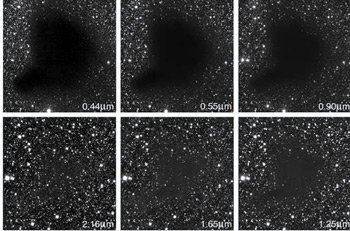Ten years since the discovery of the first extrasolar planets, the first image of a planet orbiting another star has now been obtained. These dramatic discoveries have led to a surge of interest in the whole process of star and planet formation. Stars form from clouds of molecules and dust that are so cold and dense that they do not have enough internal pressure to oppose gravitational collapse. Recent research at NUI Galway has focused on the initial conditions of star and planet formation. Specifically, is it possible to identify an individual molecular cloud that is on the verge of collapsing to form a star and possibly a planetary system? Identifying such an object is essential to constrain the competing models of star formation.
 Barnard 68 is an interstellar cloud of gas molecules mixed with solid dust particles. At optical wavelengths, the cloud blocks the background starlight but at longer wavelengths it becomes transparent (see Alves et al 2001 for more details) 1.
Figure � European Southern Observatory (ESO).
The figure depicts the molecular cloud Barnard 68 as observed by Alves et al (2001)
1
. They used the obscuration of the background starlight at different wavelengths to probe the internal structure of the cloud. They found that it contains enough material to form a single star and is close to the critical high density plus low temperature combination needed to allow the collapse to begin. So is Barnard 68 collapsing? We used the James Clark Maxwell Telescope in Hawaii to search for signatures of collapse in this cloud. This was not seen and instead the data confirmed a controversial finding by Lada et al (2003)
2
that Barnard 68 is both collapsing and expanding depending on which part of the cloud is observed. So what is going on? It seems that the cloud is undergoing oscillating 'throbbing' motions. This is a big surprise since such clouds are expected to be either stable and inert or else collapsing. Other recent evidence suggests that Barnard 68 is a rather old object and thus these throbbing motions could be stable and repetitive. This is an interesting complication as it means that clouds such as Barnard 68 could be mimicking the expected signature of a collapsing cloud yet actually could be long lived and stable. That first clear example of a cloud on the verge of collapse remains elusive.
Barnard 68 is an interstellar cloud of gas molecules mixed with solid dust particles. At optical wavelengths, the cloud blocks the background starlight but at longer wavelengths it becomes transparent (see Alves et al 2001 for more details) 1.
Figure � European Southern Observatory (ESO).
The figure depicts the molecular cloud Barnard 68 as observed by Alves et al (2001)
1
. They used the obscuration of the background starlight at different wavelengths to probe the internal structure of the cloud. They found that it contains enough material to form a single star and is close to the critical high density plus low temperature combination needed to allow the collapse to begin. So is Barnard 68 collapsing? We used the James Clark Maxwell Telescope in Hawaii to search for signatures of collapse in this cloud. This was not seen and instead the data confirmed a controversial finding by Lada et al (2003)
2
that Barnard 68 is both collapsing and expanding depending on which part of the cloud is observed. So what is going on? It seems that the cloud is undergoing oscillating 'throbbing' motions. This is a big surprise since such clouds are expected to be either stable and inert or else collapsing. Other recent evidence suggests that Barnard 68 is a rather old object and thus these throbbing motions could be stable and repetitive. This is an interesting complication as it means that clouds such as Barnard 68 could be mimicking the expected signature of a collapsing cloud yet actually could be long lived and stable. That first clear example of a cloud on the verge of collapse remains elusive.
References:
1. Alves, J. F., Lada, C. J., & Lada, E. A. 2001, Nature, 409, 159
2. Lada, C. J., Bergin, E. A., Alves, J. F., & Huard, T. L. 2003, ApJ, 586, 286
Contact: Dr Matt Redman, Department of Physics,
NUI Galway, Ireland;
E-mail:
[email protected]
|

